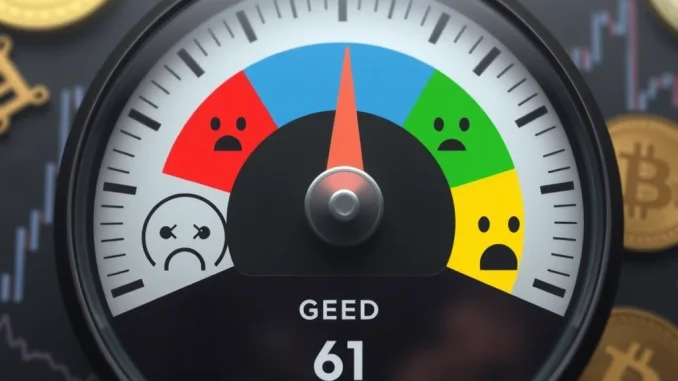
Hey crypto enthusiasts! Ever wonder how the collective mood of the market is feeling? That’s where the Crypto Fear and Greed Index comes in. It’s a handy tool designed to give us a snapshot of the prevailing emotions driving the cryptocurrency market. As of June 11, this key indicator stands at 72, a slight uptick from the previous day, and it’s firmly rooted in the ‘Greed’ zone. This reading suggests market participants are feeling quite bullish, but what does that really mean for the Bitcoin price and beyond?
Understanding the Crypto Fear and Greed Index
So, what exactly is this index and why should you pay attention to it? The Crypto Fear and Greed Index is provided by Alternative.me and aims to visualize whether the cryptocurrency market is experiencing excessive fear or excessive greed. Think of it as a thermometer for market psychology.
The index operates on a scale from 0 to 100:
- 0-24: Extreme Fear – This often signals that investors are overly worried, potentially creating a buying opportunity for those brave enough.
- 25-49: Fear – Still cautious, but less panic than extreme fear.
- 50: Neutral – The market sentiment is balanced.
- 51-74: Greed – Investors are getting optimistic and prices might be rising.
- 75-100: Extreme Greed – This suggests the market might be due for a correction as participants could be getting ahead of themselves.
The current reading of 72 places us squarely in the ‘Greed’ territory. While not yet ‘Extreme Greed’, it indicates a strong positive crypto market sentiment.
How is the Index Calculated?
The Crypto Fear and Greed Index isn’t just a random number. It aggregates data from several different sources, each weighted to contribute to the final score. Understanding these components helps shed light on the factors influencing the current crypto market sentiment.
Here’s a breakdown of the components:
- Volatility (25%): Measures the current volatility and maximum drawdowns of Bitcoin compared to its average historical values. High volatility often signals a fearful market.
- Market Momentum/Volume (25%): Compares current market volume and momentum to average values. High buying volume in a positive market suggests greedy or bullish behavior.
- Social Media (15%): Analyzes posts on various social media platforms (like Twitter) for sentiment analysis, looking at specific hashtags and keywords related to cryptocurrencies. High positive sentiment can indicate greed.
- Surveys (15%): While paused sometimes, this component involves weekly polls to gauge investor sentiment directly.
- Bitcoin Dominance (10%): Measures Bitcoin’s share of the total cryptocurrency market cap. Increasing dominance can signal fear as investors move to what they perceive as a safer asset (Bitcoin), while decreasing dominance can signal greed as they speculate on altcoins.
- Google Trends (10%): Analyzes search query data on Google for terms related to cryptocurrencies. Increasing search volume, especially for phrases like “Bitcoin price manipulation” or “crypto bubble,” can indicate fear, while general interest spikes might align with greed.
Each of these factors provides a piece of the puzzle, combining to give us the overall reading for the Crypto Fear and Greed Index.
What Does Being in the ‘Greed’ Zone (72) Tell Us?
A reading of 72, firmly in the greed zone, indicates that investors are generally feeling confident and optimistic about the cryptocurrency market. This sentiment often accompanies rising prices, as people are eager to buy in, fearing they might miss out on further gains (FOMO – Fear Of Missing Out).
Historically, high greed levels have sometimes preceded market corrections. The famous quote, “Be fearful when others are greedy, and greedy when others are fearful,” suggests that extreme readings on either end of the spectrum can be potential contrarian signals. When the index is high, it might imply the market is getting overheated, and a pullback could be on the horizon. Conversely, extreme fear often presents potential buying opportunities.
However, it’s crucial to remember that the index can stay in the greed zone for extended periods during strong bull runs. A reading of 72 doesn’t automatically mean a crash is imminent, but it does serve as a yellow flag to exercise caution and perhaps re-evaluate risk exposure.
How Does This Relate to Bitcoin Price?
The Crypto Fear and Greed Index is heavily influenced by Bitcoin because of its dominance in the market. A rising Bitcoin price and positive momentum often push the index higher into the greed zone. When Bitcoin is rallying, overall market sentiment tends to be positive, spilling over into altcoins as well.
Conversely, sharp drops in the Bitcoin price can quickly send the index plummeting into the ‘Fear’ or ‘Extreme Fear’ zones. Therefore, the index reading is often seen as a reflection of, and potentially an influence on, the Bitcoin price trajectory.
Using the Index: Benefits and Challenges
The Crypto Fear and Greed Index is a popular tool, but like any indicator, it has its pros and cons.
Benefits:
- Quick Snapshot: Provides a fast, easy-to-understand view of overall crypto market sentiment.
- Gauges Psychology: Helps in understanding the prevailing emotional state of the market participants, which is a significant driver in volatile crypto markets.
- Potential Contrarian Signal: Extreme readings can sometimes alert traders to potential overbought or oversold conditions.
Challenges:
- Not a Crystal Ball: It’s an indicator of sentiment, not a predictor of future price movements. The market can remain irrational longer than you expect.
- Can Stay Extreme: During prolonged bull or bear markets, the index can linger in extreme zones without immediate reversal.
- Limited Scope: It doesn’t account for fundamental analysis, technological developments, regulatory news, or macroeconomic factors.
- Weighting Debate: The specific weighting of the six factors can be debated and might not always reflect market dynamics perfectly.
Actionable Insights: Navigating the Greed Zone
With the Crypto Fear and Greed Index at 72, signaling significant greed, what might be some sensible approaches?
- Exercise Caution: High greed suggests optimism is peaking. This might be a time to be more cautious with new investments.
- Consider Taking Profits: If you’ve held assets that have seen significant gains, being in the greed zone could be a signal to take some profits off the table.
- Avoid FOMO Buying: Resist the urge to jump into trades purely because prices are going up rapidly. High greed environments are often driven by FOMO.
- Diversify: Ensure your portfolio isn’t overly concentrated in highly speculative assets during periods of high greed.
- Use Other Tools: Always combine the index’s reading with other technical analysis indicators, fundamental analysis, and your own risk management strategy. Don’t rely solely on the index.
Understanding the current crypto market sentiment is valuable, but it’s just one piece of the puzzle for making informed decisions in the cryptocurrency market.
Conclusion: Staying Grounded Amidst Greed
The rise of the Crypto Fear and Greed Index to 72 places the market firmly in the greed zone. This reflects a prevalent positive sentiment, likely fueled by recent market performance and a strong Bitcoin price. While optimism is high, this reading serves as a reminder of the cyclical nature of markets and the potential risks associated with excessive exuberance.
Use the index as a valuable gauge of market psychology, but temper its insights with careful analysis and a disciplined approach. Staying informed about the various factors influencing the cryptocurrency market and maintaining a long-term perspective are key to navigating periods of both fear and greed effectively.



